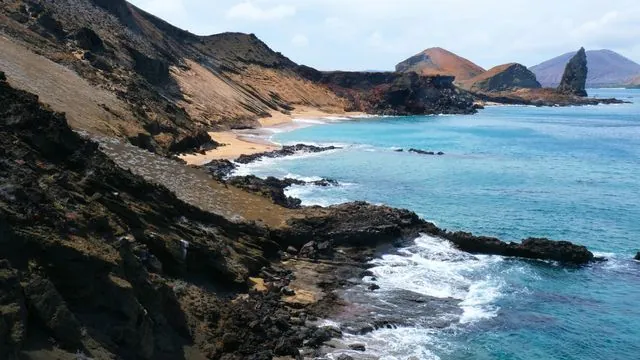
How Hunga Volcano’s Eruption in 2022 Surprised Climate Scientists with a Cooling Effect
2025-04-03
Author: Siti
Introduction
In a stunning revelation, a 2022 eruption from the Hunga Tonga–Hunga Haʻapai underwater volcano, situated in the South Pacific near Tonga, has been shown to have actually cooled the Southern Hemisphere by approximately 0.1°C, defying predictions that suggested it would push global temperatures beyond the critical 1.5°C threshold set by the Paris Climate Accords.
Unexpected Cooling Effects
A newly published study led by researchers from UCLA makes it clear that the eruption had unexpected cooling capabilities due to the formation of smaller sulfate aerosols. These aerosols reflected sunlight back into space, outweighing any potential warming from the impressive amount of water vapor that was also released during the eruption. Interestingly, while water vapor is a well-known greenhouse gas that contributes to warming, it did not enhance warming in this case, likely due to its interactions with sulfur dioxide and other atmospheric elements like ozone.
Research Insights
Ashok Gupta, the lead author of the study published in *Nature Communications Earth and Environment*, noted the implications for geoengineering strategies aimed at combating climate change. “Releasing sulfate aerosols into the stratosphere to reflect sunlight may seem straightforward,” said Gupta, “but we must consider how other atmospheric factors like water vapor and mixing processes can significantly alter intended outcomes.”
The Eruption Details
The eruption, which occurred on January 15, 2022, released vast quantities of water vapor from just beneath the ocean surface, alongside a moderate amount of sulfur dioxide. Typically, sulfur dioxide transforms into sulfate aerosols that produce a cooling effect, while excess water vapor tends to warm the atmosphere. Researchers were concerned that due to the significant quantities of high-altitude water vapor emitted, a warming effect would prevail.
Impact Analysis
To understand the eruption’s aftermath, Gupta collaborated with experts from Vanderbilt University and Pennsylvania State University to analyze how the volcanic emissions dispersed in the atmosphere over two years. Their work involved using satellite data to monitor the distribution of water vapor, sulfate aerosols, and ozone, enabling them to investigate their impact on the Earth’s energy balance.
Findings and Conclusion
The researchers discovered that these atmospheric components led to immediate net energy losses, resulting in cooling at both the atmospheric edge and near the tropopause, the boundary layer between the troposphere and stratosphere. While the cooling influence was felt most strongly in the Southern Hemisphere, there was a hint of warming in the Northern Hemisphere due to lingering water vapor.
Notably, the study emphasized that the sulfate aerosols from the Hunga Tonga eruption were smaller—roughly 50% less in size—compared to those formed after the 1991 Mount Pinatubo eruption. Their smaller size allowed for more effective reflection of sunlight, thus intensifying the cooling effect.
This groundbreaking research not only sheds light on how shallow underwater volcanic eruptions can influence atmospheric conditions but also serves as a sobering reminder of the potential complexities and unforeseen consequences of geoengineering methods aimed at climate intervention. Gupta stressed the importance of understanding atmospheric dynamics before implementing such strategies, or we risk unintentionally inviting greater climate hazards.
Funding for this crucial research came from prominent organizations, including NASA, the National Science Foundation, and the Simons Foundation. This study may provide valuable insights as the scientific community continues to grapple with the broader implications of volcanic activity for climate change.
As we look to the future, the findings surrounding the Hunga eruption highlight the intricate interplay of geological events and climate systems—an interplay that could reveal critical pathways for understanding global temperature regulation in an era of increasing environmental uncertainty.


 Brasil (PT)
Brasil (PT)
 Canada (EN)
Canada (EN)
 Chile (ES)
Chile (ES)
 Česko (CS)
Česko (CS)
 대한민국 (KO)
대한민국 (KO)
 España (ES)
España (ES)
 France (FR)
France (FR)
 Hong Kong (EN)
Hong Kong (EN)
 Italia (IT)
Italia (IT)
 日本 (JA)
日本 (JA)
 Magyarország (HU)
Magyarország (HU)
 Norge (NO)
Norge (NO)
 Polska (PL)
Polska (PL)
 Schweiz (DE)
Schweiz (DE)
 Singapore (EN)
Singapore (EN)
 Sverige (SV)
Sverige (SV)
 Suomi (FI)
Suomi (FI)
 Türkiye (TR)
Türkiye (TR)
 الإمارات العربية المتحدة (AR)
الإمارات العربية المتحدة (AR)